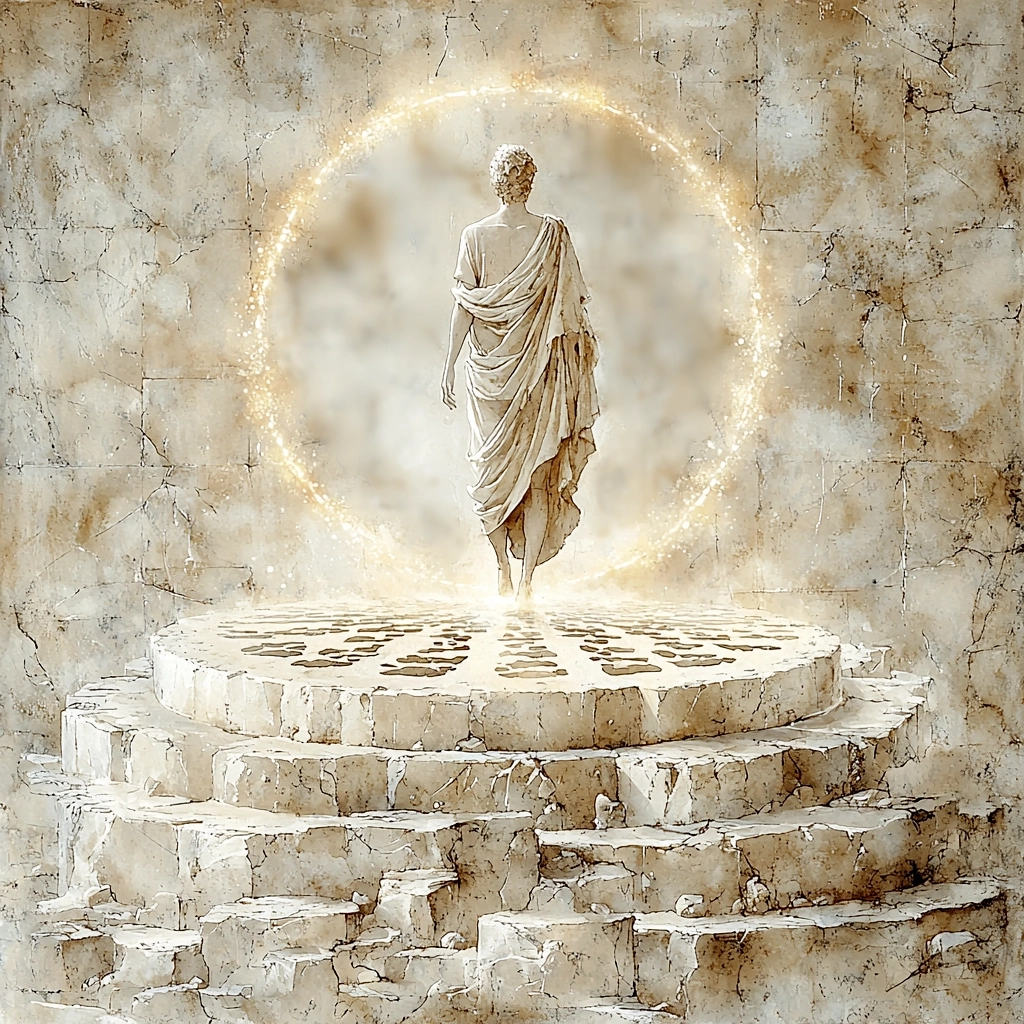🌀 Calm Through Spacetime
Staying Stoic – even with Einstein in the room
What if physics shows that most things lie beyond your reach? The Stoics would offer a simple – yet demanding – answer.
“As far as the laws of mathematics refer to reality, they are not certain; and as far as they are certain, they do not refer to reality.”
– Albert Einstein
A sentence like a laser through cotton: precise, clear—and gently disarming. Even math, it admits, must put on shoes in the real world—and sometimes get them muddy.
The Stoics would have enjoyed that idea. They knew: clarity isn’t a consolation prize, but a measuring rod. And measuring rods are rarely comfortable.
But what does that have to do with a specific metric from relativity theory—the so-called Minkowski metric? And why might it make a Stoic philosopher’s heart skip a beat while the rest of us just frown?
📀 The Minkowski Metric: Clarity for the Advanced
Let’s begin with a small fracture in reality: the Minkowski metric forms the foundation of spacetime in special relativity. It unites three spatial dimensions with time into one shared stage—where not everything is equal, but everything belongs.
Crucially, it doesn’t measure how far apart two points are in space, but how two events in spacetime relate—physically and causally. That measure is the spacetime interval, which can be positive, zero, or negative, depending on the space-time balance.
Instead of asking, “How far away is that?”, the Minkowski metric asks: “Can this even reach you—and if so, how?”
This gives rise to the famed light cone—that cone in spacetime encompassing all events that can affect you, or be affected by you. Everything else? Theoretically real, practically unreachable. Outside the cone is real but causally irrelevant.
🏛️ Stoic Principles and the Structure of the Universe
Now it gets philosophical—and surprisingly relevant. The Stoics asked the same thing: What lies within my power—and what doesn’t?
Their answer was sober – yet elegant: Only your thoughts, your judgment, your response. Everything else?
It falls under what the Stoics called the course of nature – an expression of the cosmos, guided by the Logos, embedded in the order of causes.
The similarity to Minkowski’s structure is striking: it’s all about distinguishing what concerns you—and what lies beyond your reach. The light cone is, in a sense, the physical sibling of Stoic self-limitation.
Or sharply put: The Stoics had light cones before Einstein charted them.
⚖️ Invariance and Inner Poise: Stoic Physics?
Another cornerstone of the Minkowski metric is its invariance. No matter the point of view, it stays the same. No observer sees more truth than another. The structure is stable, even when everything moves.
Sounds… Stoic? As if physics had been quietly reading Seneca all along.
The Stoic, too, lives with invariance: they view the world from shifting angles, but their standard holds. They can’t control the external—only how they interpret and respond to it.
We call that composure today. The Stoics called it: inner freedom.
🌀 The Human Within the Cone: Stoic Practice in Spacetime
The light cone may sound like something from a physics diagram—and it is—but it’s a deeply practical tool. It outlines the domain where your will, words, and actions can have impact. Outside that? Not your stage.
That defines Stoic ground: Concern yourself only with what you can reach.
That doesn’t mean apathy for the rest—but you conserve your energy. No rage at world events beyond control. No mental spirals over opinions you can’t change. No fear of outcomes beyond your causal influence.
And if you’ve already reacted to three push notifications today from beyond your cone: welcome to the gym.
🧱 What Remains Invariant When Everything Spins?
Einstein posed it to physics; the Stoics pose it to life: What stays constant when everything shifts?
The Minkowski metric offers a formal reply: the spacetime interval. The Stoics offer an existential one: your judgment, your stance, your ethos. Even when norms wobble and timelines warp, one capacity remains—to see clearly and respond rightly.
Maybe Stoicism isn’t a theory—but a navigation system. An inner compass for turbulent times. A silent gyroscope in your head—unless you knock it out of sync yourself.
A kind of mental Minkowski metric that lets you stay calm as the universe sways.
🧘 Conclusion: Clarity Isn’t Comfort—It’s Orientation
So what connects Einstein and the Stoics? Both reveal that clarity doesn’t come from control—but from understanding structure. The Minkowski metric describes the cosmos precisely—but doesn’t rule it. Stoicism offers dignity in life—not domination.
- Know the measure, and you won’t need control.
- Know your cone, and you’ll know where to stand.
A contribution by Stay-Stoic
Topic: Stoicism meets relativity – Sphere of control vs. cosmic scale.
✦ Core Thesis: The universe is vast – but your influence stays tragically local.
Please Note
The content of this post is for informational and inspirational purposes only. It does not constitute personal, psychological, or medical advice. For individual concerns, please consult an expert. Learn more: Disclaimer.
Found a spark of inspiration, found some inner calm—or at least managed to escape the daily circus for a moment? Support us so new Stoic perspectives can continue to find a home here.
👉 Become a sponsor
Join our Stoic mission.
Together, we bring more calm into the world.




